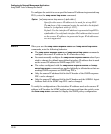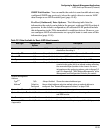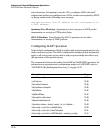
Configuring for Network Management Applications
LLDP (Link-Layer Discovery Protocol)
TLV (Type-Length-Value): A data unit that includes a data type field, a data
unit length field (in bytes), and a field containing the actual data the unit is
designed to carry (as an alphanumeric string, a bitmap, or a subgroup of
information). Some TLVs include subelements that occur as separate data
points in displays of information maintained by the switch for LLDP
advertisements. (That is, some TLVs include multiple data points or
subelements.)
General LLDP Operation
An LLDP packet contains data about the transmitting switch and port. The
switch advertises itself to adjacent (neighbor) devices by transmitting LLDP
data packets out all ports on which outbound LLDP is enabled, and reading
LLDP advertisements from neighbor devices on ports that are inbound LLDP-
enabled. (LLDP is a one-way protocol and does not include any
acknowledgement mechanism.) An LLDP-enabled port receiving LLDP
packets inbound from neighbor devices stores the packet data in a Neighbor
database (MIB).
LLDP-MED
This capability is an extension to LLDP and is available on the switches
covered in this guide. Refer to “LLDP-MED (Media-Endpoint-Discovery)” on
page 13-53.
Packet Boundaries in a Network Topology
■ Where multiple LLDP devices are directly connected, an outbound LLDP
packet travels only to the next LLDP device. An LLDP-capable device does
not forward LLDP packets to any other devices, regardless of whether
they are LLDP-enabled.
■ An intervening hub or repeater forwards the LLDP packets it receives in
the same manner as any other multicast packets it receives. Thus, two
LLDP switches joined by a hub or repeater handle LLDP traffic in the same
way that they would if directly connected.
■ Any intervening 802.1D device or Layer-3 device that is either LLDP-
unaware or has disabled LLDP operation drops the packet.
13-37


















